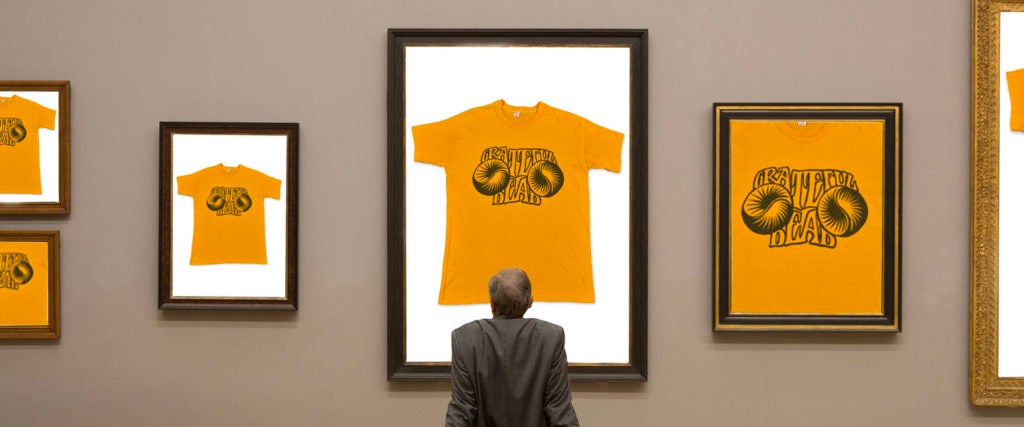Last month, members of the Grateful Dead and those from their inner circle auctioned off a plethora of musical instruments, clothing and memorabilia from across the band’s storied career. Among the pieces was a vintage T-shirt designed by the Hells Angels, Merry Pranksters and graphic artist Allan “Gut” Terk — a key counterculture figure in the 1960s who was acclaimed in the Bay Area music scene for his T-shirt and poster art. According to his own account pulled from an Instagram post, Terk designed the T-shirt “more for women than anything,” suggesting that the design of the “spinners” were meant to be worn over boobs.
Prior to the auction, estimates suggested that the T-shirt — likely only one of 150 ever made — could sell for $8,000. Instead, it was bought by the Outlaw Archive — a personal collection of 1960s motorcycle club artifacts and ephemera — for nearly $18,000, the highest price a vintage T-shirt has ever sold for. The second highest “was a Led Zeppelin shirt from the Knebworth House shows in 1979 that was around $10,000,” says Walt Weber, who owns the online vintage store The Captain’s Vintage.
Weber tells me that he got into vintage T-shirts at a young age — “I was really into glitter iron-on T-shirts with TV shows and funny sayings” — and as far he knows, Terk’s design was the first Grateful Dead T-shirt made. “In my opinion, this transcends fashion and vintage and moves directly into rock-and-roll memorabilia,” he tells me. “Items like this are so special that it’s difficult to put a price on it, but clearly they did at $18,000.”
“This isn’t just owning a guitar,” Weber continues. “This is like owning Kurt Cobain’s guitar. It’s pretty amazing; the provenance is what gives it the value.”
Similarly, Nas, a 36-year-old vintage T-shirt collector, tells me that while he thinks 18 grand is a significant amount of money, he also thinks that this particular T-shirt is more than just an object of “revisionist hype or pure nostalgia.” “I’d compare the Dead shirt with a historical artifact more than I would a work of art,” he explains. “It isn’t one of a kind — there were others like it made in the 1960s — but the elements that make up the artifact itself (age, condition, who it was designed by, who it once belonged to) make it a significant purchase as a poignant piece of history.”
Essentially, in his mind, this T-shirt lies squarely at the intersection of California/Bay Area history, Grateful Dead lore, motorcycle culture, the hippie movement and 1960s art and psychedelia. “The reason I characterize this particular T-shirt as an artifact is for a few reasons,” Nas tells me. First off, he explains, it’s a tangible, physical object just “like a dish, hammer or other ‘tool.’ It’s not really a work of art; it’s a practical piece of material.”
“But then what happens when a shirt has a further significance attached to it?” he asks. “Like a band name, or a graphic by a famous artist, or famous designer attached to it? We as a broader society designate that particular item as not only something that has utility but something that has enormous cultural relevance.”
In the example of the Grateful Dead shirt, Nas says that just the fact that it was sold by Sotheby’s means that a group of people determined, based on who owned it and what that ownership represents, that the T-shirt was worth auctioning off for a significant amount of cash. “Obviously, you don’t see this happen with any old Walmart tee — yet,” he adds.
It isn’t so much of a threat as it is a reality. Walmart-inspired or not, the Grateful Dead shirt certainly won’t be the last band T-shirt to fetch five figures — if not much, much more. “Some will inevitably exceed that value if they touch on all the important factors that the Dead shirt did,” says Nas. “The rarity of some plus the cultural and historical value we assign to them will inflate their value and desirability.”
Band tees aren’t exactly the Rosetta Stone. But they’re no longer just a collection of cotton fibers either.

